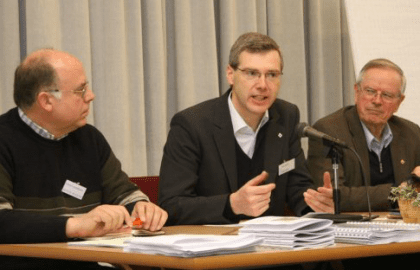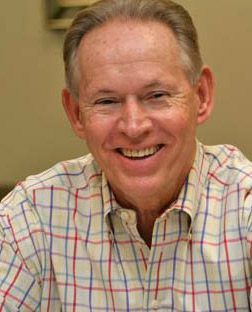
“Our SCJ spirituality applies so well to the process of aging”
Fr. Jim Schroeder
The major superiors of Europe came together last month to continue and expand a conversation begun at the 2009 General Chapter: how do the Priests of the Sacred Heart ensure quality care for their elder SCJs and how does the congregation respond to the needs of aging and dying provinces?
Previously, we noted that Fr. Jim Schroeder of the U.S. Province is a part of the General Curia’s Working Group on Aging. The group of six SCJs was developed as an advisory body to the general administration; it met for the first time in February, 2011, and is a response to the last General Chapter’s call to examine issues related to aging.
The working group helped to organize and facilitate the five-day gathering of European major superiors.
The Netherlands’ Sacred Heart Monastery in the small town of Asten was chosen as the meeting site for the March 12-16 gathering. The former Dutch novitiate is now a retirement community.
“Having the conference in a retirement house gave a sense of reality to the discussions,” said Fr. John van den Hengel, a member of the General Council and chair of the working group.

“Our house in Asten is not a skilled nursing facility but it is an example of what can be done to better allow SCJs to remain in community,” said Fr. Jim. “The building was fully remodeled for the needs of the elderly. A nurse is on duty 24 hours a day and there are also two aids. All but those who are bedridden with significant healthcare needs are able to remain at the SCJ communities in Asten or in Nijmegen.
“It was wonderful; it showed what can be done in our communities, in places like Sacred Heart at Monastery Lake. There are ways that we can help men remain in community longer… There was a strong community spirit in Asten. All the men put a priority on attending prayer and meals together, coming on their own with walkers or wheelchairs if needed.”
Although an elderly SCJ may retire from ministry, he does not retire from religious life. “SCJs make an oblation of their lives, which is central to who we are as SCJs,” said Fr. Jim. “In their oblation they can live out our spirituality. Our SCJ spirituality applies so well to the process of aging and death.”
Examples of innovation and collaboration
During the conference, each major superior was invited to talk about how his SCJ entity is addressing issues of aging.
“There were several examples of innovative communities,” said Fr. Jim.
In France, SCJs sold one of their buildings to a private corporation that now operates a senior residence for both SCJs and non-SCJs.
The North Italian Province operates a mixed senior facility that includes SCJs, diocesan priests and laity. “Several of the mothers of Italian SCJs are among the facility’s residents,” said Fr. Jim. An SCJ continues to manage the facility but there is a realization that this might not be the case in the future.
The community in Asten is also considering opening its doors to non-SCJ residents.
Shared concerns
Although there are many shared concerns in regards to aging among SCJs in North America and Europe, there are also differences. One of the most significant –– at least for the U.S. Province –– is financial.
SCJ seniors in the United States have access to Medicare, and a few have Social Security, but government benefits aren’t as strong as their European counterparts where the state often covers much of the cost for senior care.
“For this reason it is important that we have significant reserve funds in the United States to care for our senior members,” said Fr. Jim.
Curiously, economic challenges of the past few years are encouraging European governments to focus on the same thing as the Priests of the Sacred Heart: finding ways to keep elderly residents in their homes as long as possible. For SCJs, it is a way of better connecting a man to his religious community. For governments, it is simply cost effective to pay for help in the home as opposed to senior care at an assisted living or nursing facility.
Aging provinces
The care of individual SCJs is important, but it is only one piece of the equation in regards to aging in religious life. The Priests of the Sacred Heart, as do other religious congregations, have entire provinces that are aging, with average ages rising well beyond retirement levels.
The most significant example is the Dutch Province. After going for years without a new vocation the province decided to stop recruiting new members and prepare for a new reality.
Without new vocations, the province was forced to address the nuts and bolts of having an SCJ entity that might not include a significant SCJ presence in its administration. There are both canon and civil law concerns.
Myrian Wijlens, JCD, a canonist who teaches at the University of Erfurt in Germany, spoke to the group. “She is a specialist on the lacuna legis in the Code [basically, a “hole” in the law] about how to deal with aging and dying provinces,” said Fr. Jim. “Her talk was very helpful.”

The Dutch Province, now the Dutch-Flemish Confederation, is also is working to answer the question of, “how do the Priests of the Sacred Heart continue to have an imprint in an area where there are no longer members active in ministry?” said Fr. Jim.
“How do we transition out of the leadership of SCJ apostolates, and how do we determine when it is necessary?” he added.
It is a subject that hits close to home. In March, a new rector was named for Sacred Heart School of Theology and for the first time in the seminary’s 80-year existence the office will not be held by an SCJ.
“As we continue to age we will increasingly need to look at ways of furthering our collaboration with those outside of the community, especially the laity,” said Fr. Jim
Keeping the charism alive
“Several options were discussed at the conference,” said Fr. Jim. “There was talk about having younger SCJs from other countries come to places like the Netherlands to help maintain SCJ spirituality and the charism of Fr. Dehon.
“What is significant is that the call is not for young SCJs to come and take care of older members but instead to help maintain the mission of the SCJs in an area.”
Another suggestion to help keep the SCJ charsim alive is to look at promoting vocations among new immigrants to Europe.
A widespread concern
“This is a wake-up call for some provinces,” said Fr. Jim. “Even a province like Poland, which has historically had large novitiate classes year after year, is now seeing a significant decline in vocations.” No two countries are the same, but throughout Europe, and in North America, vocations to religious life and the priesthood are declining and the average age of most religious organizations, including the Priests of the Sacred Heart, is rising.
“These are not just the concerns of places like the Netherlands and France,” said Fr. Jim.
And while Africa and Asia are filled with a growing number of young SCJs, issues of aging are a concern for these entities as well. As members of a worldwide religious community, the concern of maintaining SCJ spirituality throughout the world is a concern for all; the care of the congregation’s eldest members is also a concern for all.
Message to the congregation
Participants at the Asten meeting voted to send a statement to the congregation regarding not only their gathering, but about issues of aging in general.
“What was most important was the raising of awareness and a deeper reflection by all, especially on the part of the provincial administrations, to clarify their policies on the topic of the aging of their members…” stated the message.
“We extend to you, especially our older members, a message of hope so that in old age you can remain ‘Priests of the Sacred Heart’ by making your life a ‘continuous Mass…’ Together may we may help each other to retain a vision of life that is oriented to its fullness and completion.”
Click here to read the full message.
Related reading
The March 12 National Catholic Reporter published an article titled “Study of U.S. priests: Aging is “most striking trend”
“Confirming what the U.S. Catholic community has been observing for many years — from individuals and religious orders to dioceses and their presbyterates — a soon-to-be released study on priestly ministry in the United States underscores that ‘by far, the most striking trend’ is ‘the aging of the priesthood,’” starts the article. “The study authors state that it is ‘probably the one trend that is having the most immediate impact on priestly life in the United States’ today.”
Click here to read the rest of the NCR article.

